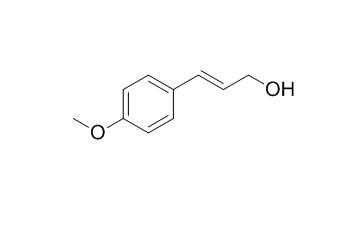4-Methoxycinnamyl alcohol
4-Methoxycinnamyl alcohol shows toxicity against MCF-7, HeLa and DU145 cancer cell line.
Inquire / Order:
manager@chemfaces.com
Technical Inquiries:
service@chemfaces.com
Tel:
+86-27-84237783
Fax:
+86-27-84254680
Address:
1 Building, No. 83, CheCheng Rd., Wuhan Economic and Technological Development Zone, Wuhan, Hubei 430056, PRC
Providing storage is as stated on the product vial and the vial is kept tightly sealed, the product can be stored for up to
24 months(2-8C).
Wherever possible, you should prepare and use solutions on the same day. However, if you need to make up stock solutions in advance, we recommend that you store the solution as aliquots in tightly sealed vials at -20C. Generally, these will be useable for up to two weeks. Before use, and prior to opening the vial we recommend that you allow your product to equilibrate to room temperature for at least 1 hour.
Need more advice on solubility, usage and handling? Please email to: service@chemfaces.com
The packaging of the product may have turned upside down during transportation, resulting in the natural compounds adhering to the neck or cap of the vial. take the vial out of its packaging and gently shake to let the compounds fall to the bottom of the vial. for liquid products, centrifuge at 200-500 RPM to gather the liquid at the bottom of the vial. try to avoid loss or contamination during handling.
J Nat Med.2020, 74(3):550-560.
Cell Death Differ.2021, 1-8.
Univerzita Karlova2022, 228192.
J Biomol Struct Dyn.2022, 5;1-17.
Antioxidants (Basel).2021, 10(11): 1802.
Sci Rep.2021, 11(1):14180.
J Ethnopharmacol.2021, 267:113615.
J Agric Food Chem.2024,72(37):20396-20409.
BMC Complement Altern Med.2014, 14:352
JPC-Journal of Planar Chromatography 2017, 30(2)
Related and Featured Products
Pharmacogn Mag. 2017 Jul;13(Suppl 2):S230-S235.
Anti-inflammatory Effect of Etlingera pavieana (Pierre ex Gagnep.) R.M.Sm. Rhizomal Extract and Its Phenolic Compounds in Lipopolysaccharide-Stimulated Macrophages.[Pubmed:
28808385 ]
In our continuing search for anti-inflammatory agents from Thai herbs, Etlingera pavieana (Pierre ex Gagnep.) R.M.Sm. showed potent inhibition on nitric oxide (NO) production in lipopolysaccharide (LPS)-induced macrophages. However, the mechanism behind its inhibitory effect has not been yet explored, and little is known regarding its bioactive compounds responsible for the anti-inflammatory effect.
In the present study, anti-inflammatory effect of hexane, ethyl acetate, and water fractions of rhizomal ethanol extracts of E. pavieana was evaluated for their inhibition on NO production and mechanism in LPS-stimulated macrophages. Active compounds responsible for such anti-inflammatory activity were identified.
METHODS AND RESULTS:
Inhibitory activities on NO production were performed in LPS-stimulated RAW264.7 macrophage. Cytotoxicity of plant extracts was measured by 3-(4,5-dimethylthiazol-2-yl)-2,5-diphenyltetrazolium bromide assay, mRNA and protein expressions by reverse transcription-polymerase chain reaction and Western blotting analysis, respectively. Anti-inflammatory compounds were isolated by activity-guided isolation technique using column chromatography.
Ethyl acetate fraction of E. pavieana (EPE) showed the most potent inhibitory effect on NO production in macrophages. EPE significantly decreased NO production and inhibited inducible nitric oxide synthase (iNOS) protein and mRNA expression in a dose-dependent manner. Furthermore, the level of nuclear factor-kappa B p65 subunit was markedly reduced in activated cells treated with EPE. Four phenolic compounds, 4-Methoxycinnamyl alcohol (1), trans-4-methoxycinnamaldehyde (2), 4-methoxycinnamyl p-coumarate (3), and p-coumaric acid (4), were obtained from bioactivity-guided isolation technique.
CONCLUSIONS:
The anti-inflammatory property contained in E. pavieana rhizome extract and conferred through inhibition of iNOS expression, and NO formation provides scientific evidence and support for the development of new anti-inflammatory agents based on extracts from this plant.
Nat Prod Res. 2015;29(18):1752-6.
Cytotoxicity of syringin and 4-methoxycinnamyl alcohol isolated from Foeniculum vulgare on selected human cell lines.[Pubmed:
25588942 ]
This study was carried out to determine the cytotoxic effect of seven plant extracts and the isolated compounds - syringin and 4-Methoxycinnamyl alcohol - on cancerous and non-cancerous cells.
METHODS AND RESULTS:
The ethanol extract of Foeniculum vulgare was found to exhibit the most significant toxicity with an IC50 value of 19.97 μg/mL on HeLa cells. Bioassay-guided fractionation led to the isolation of two compounds, syringin (1) and 4-Methoxycinnamyl alcohol (2). Both compounds showed toxicity against MCF-7, HeLa and DU145 cancer cell line.
CONCLUSIONS:
The results showed that compound 2 showed high toxicity against all the cancer cell lines with IC50 values of 14.24, 7.82 and 22.10 μg/mL, respectively. 4-Methoxycinnamyl alcohol also showed no apoptotic effect in cell cycle analysis after 48 h at a concentration of 10 μg/mL. However, DNA fragmentation study revealed that necrosis took place at a concentration of 10 μg/mL after 48 h exposure.



